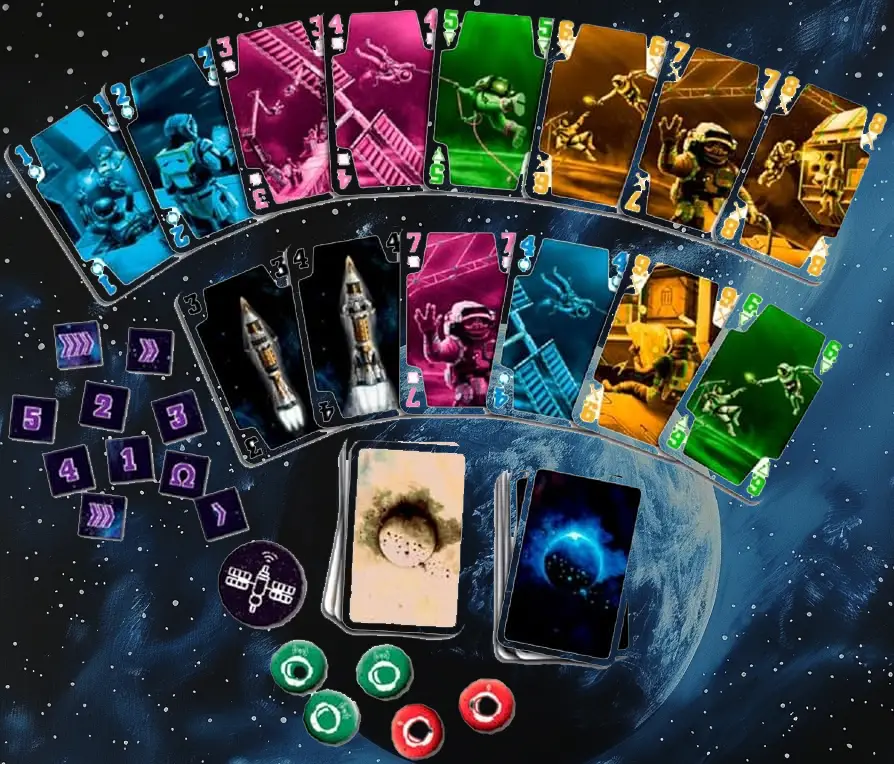
What I like about The Crew: The Quest for Planet Nine
Unique Cooperative Trick-Taking Gameplay: I’ve always been a fan of trick taking, it’s a classic mechanic that has long existed in games like Hearts or Spades or even games like Hell (as I was taught it growing up), but I never for the life of me would have considered a cooperative take to work as well as it does.
You are 2-5 players, ahem, astronauts, tasked with with specific missions, 50 of them in fact, which revolve around each player needing to take tricks based on certain criteria. Sometimes you get to choose from a pool of suits and numbers and all you have to do is ensure you get that trick before the game is over. Other times, the requirements get very specific or complex, taking multiple tricks, needing to accomplish them in a specific order, not being able to even choose what goals you have… etc. If any player doesn’t fulfill their specific mission criteria, you fail the mission as a team.
The cooperative nature of this game is a breath of fresh air. Instead of competing against each other, or worse, the semi-cooperative team effort of living up to your partners expectations of bidding or playing the right cards for games like Hearts and Spades, you are on the same team. This aspect, mixed with things you are forced to accomplish, like taking tricks in specific orders or adopting roles with limited abilities… seem to remove a lot of the stress out of your typical trick-taking games because you all just feel in the same boat…erm… ship, space ship. P
There is almost always a solution to the puzzle at hand, very rarely after analysis is it deemed “impossible” for the team to have succeeded… yet, in play, the solutions are not always obvious, and if you mess up a particular mission, while you are letting your team down by not picking up the correct order you should have played a card or maybe misjudged a specific mission goal… the games are fast enough that you never feel horrible about it. You just pick up and try again. (This does lead to an over-inflated amount of plays though, as you can see below).
Progressive Mission Structure: While not a campaign game per say, the mission structure does follow a certain progression that builds upon itself. You can open the box, play any mission, and you’d be just fine. But if you play in order, especially with the same group of players, you’ll ultimately get better as a group, discovering communication metas and playstyles, that will give you the edge as you start to tackle the hardest missions. The campaign-like progression makes each game feel different, which will keep you engaged over multiple play sessions.
Communication Restrictions Add Intrigue: While other games have had this as a feature, the limited communication rule—players can only give hints in specific ways—adds a unique puzzle aspect that actually works well. It’s harder to gamify around (unlike games like Hanabi for instance) and it encourages players to read each other’s actions, fostering a sense of synergy and collaboration that deepens over time. You have to trust you are doing something for a specific reason or giving a hint for a specific reason, even if those reasons are unclear.
Accessible and Easy to Learn: A lot of games do have this quality, so it’s not quite unique in that regard, but the fact that it copies not from other modern board games, but from classic trick-taking card games makes a teach that much easier. Sure, the more complicated missions will test even an advanced player… there should be no issues onboarding a new player for the first few missions.
Compact and Portable: While the box is a bit bigger than it needs to be, this is just cards and some chits. A few tuckboxes is all you need to make this the perfect travel game if you want it to be.

What I Do Not like about The Crew: The Quest for Planet Nine
Difficulty Spikes: Some missions have difficulty spikes that can feel frustrating. The randomness of card deals can sometimes make a mission extremely tough or feel impossible to beat, which can feel unfair, especially if you’re progressing through the campaign. That said, the longest mission took us 11 attempts, which isn’t that bad considering that games are really fast (often 10 minutes on average). There were also certainly missions where we THOUGHT would be impossible at first glance, that we tackled on our first attempt.
Player Count Dependence: The experience can vary significantly depending on the number of players. While it works with 3-5 players, the balance is often best with four players. With fewer players, some of the missions feel too easy or don’t provide the same level of challenge and teamwork. You can play with 2, but I wouldn’t recommend it from my one experience trying that out..
Replayability Diminishes After Completion: This isn’t that big of a deal for me and also not 100% true depending on your play groups. I’m of the mindset that endless replayability is a bit overrated, it’s great when it’s there, but perfectly fine when it’s not. I love legacy games, for instance. You do lose the excitement of the harder missions as your progress culminates to the last mission… but if you found yourself playing with a brand new group of players, you could easily redo the whole thing and not feel bad about it because a lot of the meta of the game revolves around the individual group synergy vs a campaign with narration spoilers.
The Theme is Kind of Pasted On: This one isn’t too negative either (although will reflect in my score). I’m not sure thematically what could be done TO make it any better, but the theme is certainly not core to the game. It may help make abstracting out the overall goals a bit easier but this could have been a game with zero imagery and would work 100% the same.
The Crew Play Log
With my main group, here is the breakdown of all the games we played, including how many attempts each mission took and the special rules associated with it.
| Mission | Attempts | Total Attempts | Tasks | Special Rules |
| 1 | 1 | 1 | 1 | |
| 2 | 2 | 3 | 2 | |
| 3 | 1 | 4 | 2 | 1,2 |
| 4 | 3 | 7 | 3 | |
| 5 | 1 | 8 | 0 | Assign: One player takes no tricks |
| 6 | 5 | 13 | 3 | >,>> |
| 7 | 2 | 15 | 3 | Ω |
| 8 | 1 | 16 | 3 | 1,2,3 |
| 9 | 1 | 17 | 0 | A ‘1’ must win a trick |
| 10 | 2 | 19 | 4 | |
| 11 | 4 | 23 | 4 | 1, Assign: One player cannot communicate. Commander does NOT confer with other players before assigning. |
| 12 | 5 | 28 | 4 | Ω, After first trick each player blindly takes one card from the right |
| 13 | 1 | 29 | 0 | Each rocket must win one trick |
| 14 | 3 | 32 | 4 | >, >>, >>> |
| 15 | 1 | 33 | 4 | 1, 2, 3, 4 |
| 16 | 2 | 35 | 0 | No 9’s can win tricks |
| 17 | 1 | 36 | 2 | No 9’s can win tricks |
| 18 | 1 | 37 | 5 | |
| 19 | 2 | 39 | 5 | 1 |
| 20 | 2 | 41 | 2 | |
| 21 | 7 | 48 | 5 | 1,2 |
| 22 | 1 | 49 | 5 | >, >>, >>>, >>>> |
| 23 | 8 | 57 | 5 | 1,2,3,4,5 |
| 24 | 2 | 59 | 6 | |
| 25 | 1 | 60 | 6 | >, >> |
| 26 | 6 | 66 | 0 | 1’s must win two tricks |
| 27 | 2 | 68 | 3 | |
| 28 | 1 | 69 | 6 | 1, Ω |
| 29 | 2 | 71 | 0 | No one can lead by two tricks |
| 30 | 1 | 72 | 6 | >, >>, >>> |
| 31 | 1 | 73 | 6 | 1,2,3 |
| 32 | 2 | 75 | 7 | |
| 33 | 1 | 76 | 0 | Assign: Win 1 trick, no rockets |
| 34 | 2 | 78 | 0 | Commander wins 1st and last tricks, no one can lead by 2 tricks |
| 35 | 3 | 81 | 7 | >,>>,>>> |
| 36 | 1 | 82 | 7 | 1,2 |
| 37 | 1 | 83 | 4 | |
| 38 | 4 | 87 | 8 | |
| 39 | 11 | 98 | 8 | >,>>,>>> |
| 40 | 4 | 102 | 8 | 1,2,3 |
| 41 | 6 | 108 | 1 | Assign: Only win first and last |
| 42 | 4 | 112 | 9 | |
| 43 | 1 | 113 | 9 | |
| 44 | 1 | 114 | 0 | Rockets must win in ascending order |
| 45 | 1 | 115 | 9 | >,>>,>>> |
| 46 | 5 | 120 | 0 | Player to left of Red 9 must win all red cards. Reveal who has the red 9 before starting |
| 47 | 1 | 121 | 10 | |
| 48 | 5 | 126 | 3 | Ω |
| 49 | 2 | 128 | 10 | >, >>, >>> |
Last Updated: 10/16/24
Wakasm's Report Card of Arbitrary Values for The Crew: The Quest for Planet Nine







I have played The Crew: The Quest for Planet Nine 133 times!



/pic7779581.png)